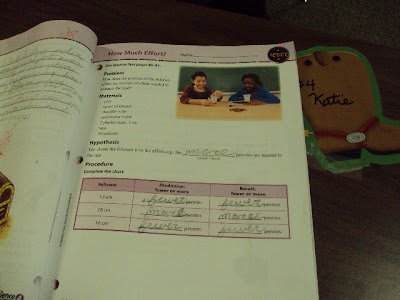 We set up our materials. The cup closest to zero on the ruler was labeled "Effort"and the cup at the other end of the ruler was labeled "Load". The spool was the fulcrum. Pennies were to be added or removed from the "Effort" depending on where the fulcrum was placed. We first placed ten pennies in each cup to balance both sides. Nice balancing!
We set up our materials. The cup closest to zero on the ruler was labeled "Effort"and the cup at the other end of the ruler was labeled "Load". The spool was the fulcrum. Pennies were to be added or removed from the "Effort" depending on where the fulcrum was placed. We first placed ten pennies in each cup to balance both sides. Nice balancing!  Next we wrote our hypothesis: "The closer the fulcrum is to the effort cup, the (fill in the blank with either "more" or "fewer") pennies are needed in the cup.
Next we wrote our hypothesis: "The closer the fulcrum is to the effort cup, the (fill in the blank with either "more" or "fewer") pennies are needed in the cup.When we moved the spool of thread to 13cm on the ruler, we found that we could remove several pennies from the "effort" cup. Less work!!!!
 Moving the fulcrum to 18cm meant even fewer pennies in the "effort" cup (actually just 2).
Moving the fulcrum to 18cm meant even fewer pennies in the "effort" cup (actually just 2).
 Moving the fulcrum to the 10 cm mark on the ruler meant more pennies (representing effort) were needed.
Moving the fulcrum to the 10 cm mark on the ruler meant more pennies (representing effort) were needed.
 We concluded that when the fulcrum was closer to the effort, we needed more effort (pennies). That means if we use a lever to try to move a heavy object, we need to move the fulcrum so there is the most distance possible between the effort and the fulcrum.
We concluded that when the fulcrum was closer to the effort, we needed more effort (pennies). That means if we use a lever to try to move a heavy object, we need to move the fulcrum so there is the most distance possible between the effort and the fulcrum.
 Oops! Looks like we have a few corrections to make on this person's results on the chart. Maybe we better try this experiment one more time on Monday, just to be sure!!!!!
Oops! Looks like we have a few corrections to make on this person's results on the chart. Maybe we better try this experiment one more time on Monday, just to be sure!!!!!
 Moving the fulcrum to 18cm meant even fewer pennies in the "effort" cup (actually just 2).
Moving the fulcrum to 18cm meant even fewer pennies in the "effort" cup (actually just 2). Moving the fulcrum to the 10 cm mark on the ruler meant more pennies (representing effort) were needed.
Moving the fulcrum to the 10 cm mark on the ruler meant more pennies (representing effort) were needed.  We concluded that when the fulcrum was closer to the effort, we needed more effort (pennies). That means if we use a lever to try to move a heavy object, we need to move the fulcrum so there is the most distance possible between the effort and the fulcrum.
We concluded that when the fulcrum was closer to the effort, we needed more effort (pennies). That means if we use a lever to try to move a heavy object, we need to move the fulcrum so there is the most distance possible between the effort and the fulcrum.  Oops! Looks like we have a few corrections to make on this person's results on the chart. Maybe we better try this experiment one more time on Monday, just to be sure!!!!!
Oops! Looks like we have a few corrections to make on this person's results on the chart. Maybe we better try this experiment one more time on Monday, just to be sure!!!!!
No comments:
Post a Comment